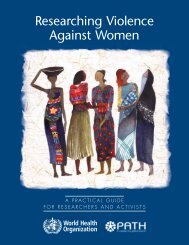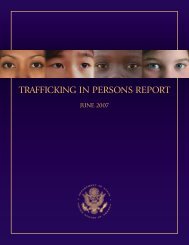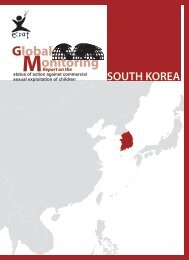Download PDF - Violence Against Children - East Asia and the ...
Download PDF - Violence Against Children - East Asia and the ...
Download PDF - Violence Against Children - East Asia and the ...
You also want an ePaper? Increase the reach of your titles
YUMPU automatically turns print PDFs into web optimized ePapers that Google loves.
conclusion<br />
“The only thing necessary for <strong>the</strong><br />
triumph of evil is for good [people]<br />
to do nothing.”<br />
– Edmund Burke (British political philosopher) 1<br />
If this study has one underpinning message, it<br />
is that all members <strong>and</strong> levels of society have<br />
important roles to play in child protection,<br />
but we must act on <strong>the</strong>m. This study has<br />
described examples of children, families,<br />
communities, local government <strong>and</strong> law<br />
enforcement bodies, civil society groups, NGOs<br />
<strong>and</strong> International Organisations <strong>and</strong> funding<br />
partners promoting <strong>the</strong> right of children to be<br />
protected from exploitation, abuse <strong>and</strong> neglect.<br />
We must avoid an incomplete commitment<br />
that extends only to principle, not practice.<br />
When we know of <strong>the</strong> suffering that<br />
accompanies abuse, we cannot shut our eyes,<br />
or block our ears. A course of calculated action<br />
is needed even when that involves “speaking<br />
truth to power”. 2<br />
Building will for change<br />
Approaches that build political will, challenge<br />
negative community attitudes or demonstrate<br />
alternatives are to be encouraged. It is<br />
important to base child protection efforts on a<br />
country’s commitment to <strong>the</strong> Convention on <strong>the</strong><br />
Rights of <strong>the</strong> Child (CRC). Expressed simply: if<br />
<strong>the</strong> will is <strong>the</strong>re, action can follow.<br />
Complicating factors such as conflict, poverty,<br />
discrimination <strong>and</strong> access have been highlighted<br />
in this report as barriers, but models to reduce<br />
<strong>the</strong>ir effects have been developed <strong>and</strong> in many<br />
cases have demonstrated impact. Barriers<br />
experienced have also created opportunities for<br />
research that has led to better underst<strong>and</strong>ing of<br />
<strong>the</strong> dimensions of problems <strong>and</strong> more effective<br />
advocacy <strong>and</strong> initiatives for change.<br />
It is said that “<strong>the</strong> price of liberty is eternal<br />
vigilance”. The freedom of children from<br />
exploitation, abuse <strong>and</strong> neglect dem<strong>and</strong>s our<br />
best efforts to review, research <strong>and</strong> respond, to<br />
both current <strong>and</strong> new or emerging issues.<br />
Building capacity for change<br />
Actions <strong>and</strong> interventions at many levels can<br />
make a difference for children if <strong>the</strong>y are<br />
designed with this as a consideration.<br />
Inclusion of priorities for children is needed<br />
as much in large-scale structural adjustment<br />
programs authored by international financial<br />
organisations as in local community<br />
development efforts. Commitment to child<br />
protection must be built into planning, human<br />
resource development, <strong>and</strong> action, to ensure<br />
rhetoric becomes reality.<br />
To link <strong>the</strong> “micro”, “meso” <strong>and</strong> “macro”<br />
aspects of child protection, promotion of<br />
change at different levels is needed. In most<br />
contexts, <strong>the</strong> mechanisms that already exist<br />
to respond to issues of child protection do<br />
not work as well as <strong>the</strong>y could or should.<br />
Each of <strong>the</strong> countries covered by <strong>the</strong> study<br />
has structures that do or could promote child<br />
protection at national level; <strong>the</strong>se structures<br />
offer opportunities for input <strong>and</strong> in many<br />
cases can be used or supported more than<br />
<strong>the</strong>y currently are.<br />
Approaches to child protection need to<br />
start with <strong>the</strong> family, which is or should be<br />
<strong>the</strong> point of primary support for <strong>the</strong> child.<br />
The community – local environments <strong>and</strong><br />
wider relationships that form a backdrop for<br />
<strong>the</strong> growing child – also need to be engaged<br />
to play a more supportive role in child<br />
protection. Government agencies <strong>and</strong><br />
institutions can become increasingly childfriendly,<br />
such as an education system<br />
incorporating <strong>the</strong> CRC into staff training <strong>and</strong><br />
<strong>the</strong> general curriculum.<br />
1<br />
2<br />
Quoted in Amnesty International, Campaigning Manual, 1997<br />
“Speak truth to power” was a challenge given to Friends (Quakers) in <strong>the</strong> 18th century, <strong>and</strong> became a resounding call during <strong>the</strong> 1950s civil rights<br />
movement in <strong>the</strong> USA.<br />
83

















